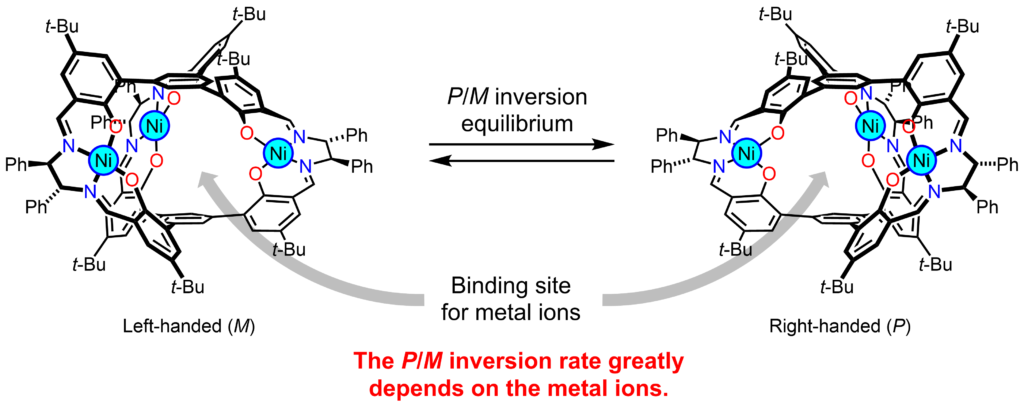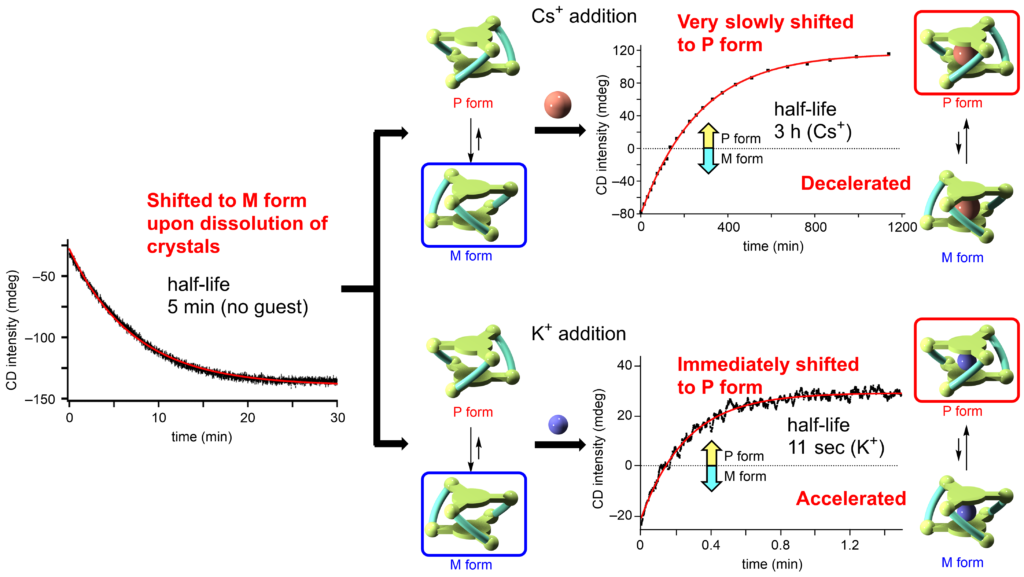Researchers at Kanazawa University report in Science Advances how they can accelerate and decelerate chirality inversion in large cage molecules using alkali metal ion binding.
————————————————————————————————————————————————————————————————
Chiral molecules can have dramatically different functional properties while sharing identical chemical formulae and almost identical structures. The molecular structure of two types of a chiral molecule – so-called enantiomers – are mirror images of each other where one cannot be superposed on the other any more than your right hand can fit front-to-back on the left. While a lot of chiral molecules are traditionally considered fixed as left- or right-handed, chiral molecules based on helices are known to be able to switch in response to changes in their environment. Now researchers led by Shigehisa Akine at Kanazawa University have demonstrated how environmental changes can also accelerate or decelerate this chiral inversion process, providing “a novel time-programmable switchable system”.
The researchers focused their study on “metallocryptand (R6)-LNi3“, an organic molecule featuring metal atoms in a cage-like molecular structure that can exist in one of two possible forms described as the P or M type (right- and left-handed, respectively) (Fig. 1). In its pure form (R6)-LNi3 has a preferred ratio of P type to M type of 12:88. Starting from a 50:50 ratio, the molecules will flip between one form and the other with a preference for flipping towards the M type to meet that ratio. The researchers measured this change in ratio using NMR and circular dichroic spectroscopy. However add an alkali metal into the cage cavity and this preference can change.
By adding alkali metal ions to the solution of the (R6)-LNi3 the researchers could confirm that the metal ions readily bound to the metallocryptand from the changes in the spectroscopic signatures of the molecules. In addition the bound ion also shifted the preferred ratio by a margin and with a speed that depended on which alkali metal was used.
The researchers attribute the different rates and ratios to differences in binding constants not just between the metal ion and the two forms of the molecule but also a virtual binding constant for the molecule transitioning between the two. The binding between caesium ion and the P type molecule was more than 20 times greater than that with the M type so the solution eventually switched to a higher proportion of the P type with a P:M ratio of 75:25 over the course of 21 hours. The final ratio with rubidium ion was similarly bias to the P type reaching a slightly lower ratio of 72:28 but in just 100 minutes. With potassium ion the equilibrium ratio was lower again at 68:32 but reached within just a minute, three orders of magnitude faster than for the caesium ion (Fig. 2). The researchers attribute this speed to the large virtual bonding constant with the transitioning molecule.
With smaller ions – lithium and sodium ions – the preferred molecular type did not actually change but the final ratio was reached much faster. It is the first time researchers have demonstrated that such chiral inversion can be sped up and slowed down by tuning the molecules environment.
“This research can provide a new insight into the development of an on-demand time-programmable molecular clock for new generation chemical technologies,” conclude the research, citing as possible future technologies a memory device with a controllable chemical information processing time, as well as chiral sensors whose selectivity is invertible depending on the situations.
Fig. 1: Structural diagrams of P and M forms of helical metallocryptand (R6)-LNi3, which has a binding site for metal ions. The P/M inversion rate greatly depends on the metal ions.
Fig. 2: The conversion from M type to P type upon the addition of metal ions. The Cs+ addition caused very slow M→P conversion whereas K+ addition caused quick M→P conversion.
Glossary
Chiral molecules
Chiral molecules come in two types or enantiomers that are mirror inversions of each other and cannot be superposed. The type is often referred to as the handedness of the molecule, likening them to the right and left hand, which also cannot be superposed.
Chirality often results from a “chiral centre” such as a carbon atom, where the four limbs describing its tetrahedral bonding directions offer the opportunity for two arrangements of the groups on each limb that are mirror images of each other. This type of chirality is traditionally considered fixed, although researchers have recently demonstrated that it is possible for one enantiomer to convert to the other for these molecules (www.doi.org/10.1038/s41557-023-01156-7)
Another source of chirality is molecules with some kind of helical structure that can either spiral one way or the other. Helical chirality is known to be able to switch between one enantiomer and the other but until now it has not been possible to both accelerate and decelerate the process.
(R6)-LNi3
The molecule (R6)-LNi3 is a metallocryptand. The term cryptand takes its name from the term crypt, which refers to the vesicle feature of the molecule that can contain other atoms. The molecule also incorporates nickel(II) ions and a helical structure that gives it chirality.
NMR
Nuclear magnetic resonance looks at the response of nuclear spins to magnetic fields. It gives an indication of the environment of the nucleus and so the molecular structure. The researchers also defined the binding constants of the molecules by integrating the NMR spectra obtained.
Circular dichroism
Circular dichroism was one of the first techniques developed to determine chirality and remains one of the most regularly used. It is based on the Cotton effect, first reported by French physicist Aimé Cotton, whereby the plane of polarization of light that passes through a chiral molecule will rotate to the right or left depending on the handedness of the molecule, and the absorption of circularly polarized light will differ depending on whether it is polarized clockwise or anticlockwise.
Reference
Authors: Sk Asif Ikbal, Pei Zhao, Masahiro Ehara, and Shigehisa Akine.
Title: Acceleration and deceleration of chirality inversion speeds in a dynamic helical metallocryptand by alkali metal ion binding
Journal: Science Advances
Published on Nov 3, 2023
DOI: 10.1126/sciadv.adj5536
URL: https://doi.org/10.1126/sciadv.adj5536









